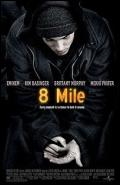Chapter 4: 8 Mile Is About Finding Your Own Way, Pursuing Your Dreams
Recalled Mekhi Phifer, who emerged as a major film talent when director Spike Lee and producer Martin Scorsese cast him as the lead character in their movie adaptation of Richard Price's Clockers: "When they first told me about the project, I wasn't excited. I didn't even want to read it. I thought it was going to be a rapper movie, and I'm not interested in doing that type of film. But after meeting Curtis, I learned that 8 Mile is comedy, it's drama, it's action, it's multi-genre. It's about finding your own way, what really makes you happy, pursuing your dreams and not letting your talent go to waste."
The backdrop and rehearsal process swept the actors into a kind of crusade for truth that brought art and life together. "We came to this project with no false pretenses," said Phifer. "We came with our passion, ready to work. We came to better the project and make it our own. Rehearsals helped define our relationships. We changed and enhanced the dynamics between the characters, making them stronger and understanding their motivations."
Hanson's overriding goal throughout production was to make the movie feel authentic: "I wanted the movie to feel real. Natural. Almost documentary-like. I loved exploring the world this story takes place in and I wanted the audience to feel that they actually went into that world, too."
His crew was chosen with this primary mission in mind. In order to capture the reality he was seeking and the authentic texture of Detroit, Hanson selected a group of collaborators who straddle the line between independent and mainstream cinema, including Mexican-born cinematographer Rodrigo Prieto (Amores Perros, Frida), production designer Philip Messina (Ocean's Eleven, Traffic, Erin Brockovich), costume designer Mark Bridges (Boogie Nights, Punch-Drunk Love) and film editors Jay Rabinowitz (Requiem for a Dream, Affliction) and Craig Kitson (Wonder Boys).
Prieto's much praised work in Alejandro Gonzalez Inarritu's Amores Perros impressed Hanson with its realistic depiction of life on the streets of one of the world's toughest urban environments, Mexico City. "After doing period pieces like Frida and Original Sin," said Prieto, "I was excited to do another urban film more in the style of Amores Perros. Curtis said that he wanted 8 Mile to look and feel 'like a weed emerging from the sidewalk. ' I really loved that image."
"When I first read the script," recalled Messina, "my initial feeling was that it was set in a world that was kind of alien to me. But Curtis made it clear that we weren't going to make a 'rap movie. ' We were going to make a movie about a journey. Then I knew that I could delve into a world that I hadn't been exposed to before, and try to make it really ring true. The most important task, from the design point of view, was to make it real."
While there were initial discussions about shooting the film somewhere other than Detroit, these plans were quickly rejected. Explained Brian Grazer: "It was very important to make this movie in Detroit, particularly for Curtis, who wanted it to feel as authentic as it possibly could. And after seeing the film, you can see that it couldn't have been done in any other place."
Making a movie in Detroit isn't easy. Making a movie in Detroit in the middle of winter is a challenge. Nonetheless, the artists behind 8 Mile found themselves quickly falling in step with the city. "Getting to know Detroit was a revelation," said Hanson. "Everywhere you looked you'd see evidence of the city that used to be - the city that promised a future to all who came there and now appeared to promise nothing. It was the perfect setting both visually and thematically for our story."
|
